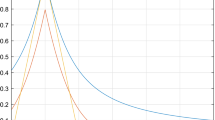Abstract
We consider the problem of maximizing the expected amount of time an exponential martingale spends above a constant threshold up to a finite time horizon. We assume that at any time the volatility of the martingale can be chosen to take any value between \(\sigma _1\) and \(\sigma _2\), where \(0 < \sigma _1 < \sigma _2\). The optimal control consists in choosing the minimal volatility \(\sigma _1\) when the process is above the threshold, and the maximal volatility if it is below. We give a rigorous proof using classical verification and provide integral formulas for the maximal expected occupation time above the threshold.

Similar content being viewed by others
References
Althöfer, I., Beckmann, M., Salzer, F.: On some random walk games with diffusion control. Advances in Computer Games, pp. 65–75. Springer, Switzerland (2015)
Demengel, G.: Transformations de Laplace: théorie et illustrations par les exemples. Ellipses Éd. Marketing, Paris Cedex (2002)
Folland, G.B.: Fourier Analysis and Its Applications. The Wadsworth & Brooks/Cole Mathematics Series. Wadsworth & Brooks/Cole Advanced Books & Software, Pacific Grove (1992)
Jeanblanc, M., Yor, M., Chesney, M.: Mathematical Methods for Financial Markets. Springer Finance. Springer-Verlag, London Ltd, London (2009)
Karatzas, I., Shreve, S.E.: Brownian Motion and Stochastic Calculus. Volume 113 of Graduate Texts in Mathematics, 2nd edn. Springer, New York (1991)
Keilson, J., Wellner, J.A.: Oscillating Brownian motion. J. Appl. Probab. 15(2), 300–310 (1978)
McNamara, J.M.: Optimal control of the diffusion coefficient of a simple diffusion process. Math. Oper. Res. 8(3), 373–380 (1983)
Nakao, S.: On the pathwise uniqueness of solutions of one-dimensional stochastic differential equations. Osaka J. Math. 9, 513–518 (1972)
Papoulis, A.: The Fourier Integral and Its Applications. McGraw-Hill, New York (1962)
Rogers, L.C.G., Williams, D.: Diffusions, Markov Processes, and Martingales. Cambridge Mathematical Library. Cambridge University Press, Cambridge (2000)
Rudin, W.: Real and Complex Analysis, 3rd edn. McGraw-Hill Book Co., New York (1987)
Acknowledgments
S.A. thanks the Ecole Centrale de Lyon for the kind invitation in May 2015, and the University of Jena for granting a sabbatical leave in the summer 2015. M.J. thanks Jena University for the fruitful invitation in March 2015. The research of M.J. is supported by the Chaire Marchés en Mutation (Fédération Bancaire Française). C.B. thanks Jena University for the invitation in July 2015. We are grateful to Ingo Althöfer for drawing our attention to the topic of diffusion control. Moreover, we thank seminar participants at METU Ankara and the University of Duisburg-Essen for helpful comments.
Author information
Authors and Affiliations
Corresponding author
Appendix
Appendix
We give here the proof that the function \({\hat{g}}\) defined by (18) is causal. We remark that the proof uses standard arguments that can be found e.g. in [2].
Lemma 6.1
For \(t<0\), \({\hat{g}}(t)=0\).
Proof
Let \(t<0\). Observe that the function \(z\mapsto e^{zt}F(z)\) is holomorphic on D. Let \(C_R\) be the line \([-Ri, Ri]\) added by the right-hand side semicircle \(\Gamma _R\) from Ri to \(-Ri\). Then
To prove that \({\hat{g}}\) is causal, it is enough to prove that \(\lim _{R \rightarrow \infty } \int _{\Gamma _R} e^{zt}F(z)dz=0.\) On \(\Gamma _R\), one has \(|e^{zt}|=e^{tR \cos \theta }\). Moreover, for all \(\epsilon >0\), there exists R large enough such that \(|F(z)|<\epsilon \), for \(z \in \Gamma _R\). Then
As \(t<0\) and \(\sin (\theta ) \ge 2\theta /\pi \), for \(\theta \in [0, \pi /2]\), we obtain
and hence the result.
Rights and permissions
About this article
Cite this article
Ankirchner, S., Blanchet-Scalliet, C. & Jeanblanc, M. Controlling the Occupation Time of an Exponential Martingale. Appl Math Optim 76, 415–428 (2017). https://doi.org/10.1007/s00245-016-9356-2
Published:
Issue Date:
DOI: https://doi.org/10.1007/s00245-016-9356-2



